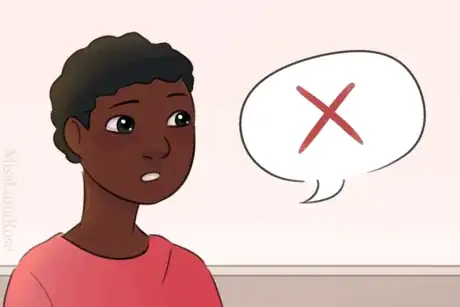This article was co-authored by Lauren Urban, LCSW. Lauren Urban is a licensed psychotherapist in Brooklyn, New York, with over 13 years of therapy experience working with children, families, couples, and individuals. She received her Masters in Social Work from Hunter College in 2006, and specializes in working with the LGBTQIA community and with clients in recovery or considering recovery for drug and alcohol use.
There are 10 references cited in this article, which can be found at the bottom of the page.
wikiHow marks an article as reader-approved once it receives enough positive feedback. This article received 22 testimonials and 90% of readers who voted found it helpful, earning it our reader-approved status.
This article has been viewed 756,496 times.
Nonviolent Communication (NVC)[1]
includes a simple method for clear, empathic communication, consisting of four areas of focus:
- Observations
- Feelings
- Needs
- Requests
NVC aims to find a way for all present to get what really matters to them without the use of guilt, humiliation, shame, blame, coercion, or threats. It is useful for resolving conflicts, connecting with others, and living in a way that is conscious, present, and attuned to the genuine, living needs of yourself and others.
Steps
Practicing NVC
-
1State the observations that are leading you to feel the need to say something. These should be purely factual observations, with no component of judgment or evaluation. People often disagree about evaluations because they value things differently, but directly observable facts provide a common ground for communication. For example,
- "It's 2:00 a.m. and I hear your stereo playing" states an observed fact, while "It's way too late to be making such an awful racket" makes an evaluation.
- "I just looked in the refrigerator and saw that there's no food, and I'm thinking that you didn't go grocery shopping" states an observed fact (with an inference explicitly stated), while "You wasted the whole day" makes an evaluation.
-
2State the feeling that the observation is triggering in you. Or, guess what the other person is feeling, and ask. Naming the emotion, without moral judgment, enables you to connect in a spirit of mutual respect and cooperation. Perform this step with the aim of accurately identifying the feeling that you or the other person are experiencing in that moment, not with the aim of shaming them for their feeling or otherwise trying to prevent them from feeling as they do. Feelings are sometimes hard to put into words.[2]
- For example, "There's half an hour to go before the show starts, and I see that you're pacing (observation). Are you nervous?"
- "I see your dog running around without a leash and barking (observation). I'm scared."
Advertisement -
3State the need that is the cause of that feeling. Or, guess the need that caused the feeling in the other person, and ask. When our needs are met, we have happy, pleasant feelings; when they are not met, we have unpleasant feelings. By tuning into the feeling, you can often find the underlying need. Stating the need, without morally judging it, gives you both clarity about what is alive in you or the other person in that moment.
- For example, "I see you looking away while I'm talking, and you've been speaking so quietly, I can't hear you (observation). Please speak up so I can understand.
- "I'm feeling lonely (feeling) because I'm needing connection right now. Is now a good time to hang out?"
- "I saw that your name wasn't mentioned in the acknowledgments. Are you feeling upset that your hard work isn't being acknowledged?"
- The word "needs" has a special meaning in NVC: every need is common to all people and not tied to any particular circumstance or strategy for fulfilling it.[3] So, wanting to go to a movie with someone is not a need and a desire to spend time with a specific person is not a need. The need in that case might be companionship. You can meet your need for companionship in many ways, not just with that specific person and not just by going to a movie.[4]
-
4Make a concrete request for action to meet the need just identified. Ask clearly and specifically for what you want right now, rather than hinting or stating only what you don't want. For the request to really be a request—and not a demand—allow the other person to say no or propose an alternative. You take responsibility for getting your own needs met, and you let them take responsibility for theirs.
- "I notice that you haven't spoken in the last ten minutes (observation). Are you feeling bored? (feeling)" If the answer is yes, you might bring up your own feeling and propose an action: "Well, I'm bored, too. Hey, how would you like to go to the Exploratorium?" or perhaps, "I'm finding these people really interesting to talk with. How about we meet up in an hour when I'm done here?"
Handling Boundaries
Nonviolent Communication is an idealized style of communication, and it will not work in every single situation. Here is how to do it well, and recognize when a more direct, assertive communication style is necessary.
-
1Make sure a person is open to nonviolent communication. NVC uses a type of emotional intimacy that not all people are comfortable with all the time, and they have the right to set boundaries. If someone is not open to expressing their feelings, do not push or manipulate them into doing so.
- Do not start psychoanalyzing someone without their consent.[5]
- If at any time someone no longer wants to talk about their feelings, they have the right to do so and can leave the conversation.
- People with intellectual and developmental disabilities, especially when stressed, may have trouble speaking in and interpreting NVC style. If this is the case, use clear and direct communication.
-
2Recognize that no one is responsible for someone else's feelings. You are not required to change your actions just because someone else doesn't like them. If someone is asking you to bend over backwards or ignore your own wants and needs, you are allowed to say no.
- You shouldn't have to sacrifice yourself and your needs for another person.[6]
- If someone is behaving aggressively, you can ask yourself what they need. However, this can be emotionally draining work, and it is okay to walk away and say "their negativity is not my problem."
- People are not obligated to cater to your feelings. If someone says no to your request, avoid getting angry or guilt-tripping them.
-
3Be aware that nonviolent communication can be abused. People may use NVC to hurt others, and it is important to be able to recognize when this happens. Sometimes you don't need to meet someone's "needs." It's important to remember that tone is less important than what the person has to say, and some feelings should not be shared.
- Abusers can use NVC to control others. For example, "I feel disrespected when you don't check in with me every 15 minutes."
- Criticism of tone can be used to derail a conversation about someone's needs (e.g. "I feel hurt when you say you're upset with me" or "I feel attacked when you use that tone"). People have a right to be heard, even if they can't say things in a way that will please everyone.
- No one should be forced to listen to deeply negative feelings about them. For example, it is not appropriate for a parent to tell their autistic child how horrible it is to put up with them, or for someone to tell a Muslim that they feel all Muslims should be deported. Some ways of expressing feelings can be abusive.
-
4Recognize that some people may not care about your feelings. Saying "I feel humiliated when you make fun of me in front of my peers" isn't going to do anything if the other person doesn't care how you feel. Nonviolent communication can work wonders when people are accidentally hurting each other, but not when it is done on purpose, or when one party doesn't care whether they are hurting someone or not. In these cases, it's better to be clear by saying "stop it," "leave me alone," or "that hurts."
- Sometimes, if someone is upset with you, it isn't because you are doing something wrong. If one person is attacking another, both sides are not equally valid.
- Placing value judgments like "she is being mean" or "this is unfair and not my fault" is sometimes necessary, especially for abuse victims, oppressed people, bullying victims, and other people who need to protect themselves from others.
Communicating Well
-
1Decide upon the solution together, if possible. When you do something together, you want it to be because you both voluntarily consent to it, as a way of fulfilling your own genuine needs and desires, not out of guilt or pressure. Sometimes you can find an action that meets both your needs, and sometimes you just have to amiably go your separate ways.
- If you're not ready to ask in this spirit, maybe you need more time, or more empathy. Or perhaps your instincts are telling you that this person does not care about your feelings. Reflect on what is stopping you.
-
2Listen closely to what the other person says. Don't assume that you know how they feel or what is best for them. Instead, let them express their thoughts and feelings. Validate their feelings, slow down to ensure they feel heard, and make it clear that you care.
- If you spend too much time labeling their needs, they might feel like you are trying to play therapist instead of actually hearing what they have to say. Put the focus on what they are telling you, not on what you have decided they "actually" mean.
-
3Take a break if one or both parties are too stressed to handle the conversation. If you're getting too upset to speak thoughtfully and clearly, the other person is unwilling to talk openly, or either one of you wants to end the conversation, stop. You can have it at a better time, when both parties are willing and able.
- If conversations consistently end badly with someone, take a close look at the situation, because there may be a deeper problem.
Community Q&A
-
QuestionHow do I address an older student who seems angry and refuses to participate in class projects?
 Alexa roseCommunity AnswerIf this kid is having issues, then you approach them in a gentle, yet firm way. Ask the student if he or she would like to discuss if he/she is having a hard time with school or at home. Show him/her that you care and that you are willing to listen.
Alexa roseCommunity AnswerIf this kid is having issues, then you approach them in a gentle, yet firm way. Ask the student if he or she would like to discuss if he/she is having a hard time with school or at home. Show him/her that you care and that you are willing to listen. -
QuestionMy husband does not always like to hear my opinion and thinks I am arguing. I am just sharing my thoughts without meaning any harm. He gets so angry with me. What do I do?
 Community AnswerBefore you start the conversation, tell him that you would like to share how you feel with him. If he just can't stand listening to you express your feelings, than he might not be the right guy. In a relationship, communication is key. If you feel like you can't express your feelings, that is not good. Try asking him specifically what bothers him about the way you share your opinions. Couples counseling might also be a good option to help you guys get through this.
Community AnswerBefore you start the conversation, tell him that you would like to share how you feel with him. If he just can't stand listening to you express your feelings, than he might not be the right guy. In a relationship, communication is key. If you feel like you can't express your feelings, that is not good. Try asking him specifically what bothers him about the way you share your opinions. Couples counseling might also be a good option to help you guys get through this. -
QuestionHow do I tell someone nicely that she is not a good friend?
 Community AnswerJust tell that someone the truth about how you feel about it.
Community AnswerJust tell that someone the truth about how you feel about it.
Sentence templates
Sometimes, a memorized sentence template can help structure what you need to say:
- "Are you feeling ____ because you need ____?" Empathize as well as you can to fill in the blanks, and you'll likely find yourself seeing the situation as the other person does.
- "Are you angry because you're thinking ____?" Anger is triggered by thoughts, like "I think you lied" or "I think I deserve a raise more than so-and-so did." Uncover the thought, and you are on your way to uncovering the underlying need.
- "I'm wondering if you're feeling ____" is another way to empathize, without explicitly asking a question. The phrasing makes clear that this is your guess, and not an attempt to analyze the other person or tell them what they are feeling.
- "I see ____" or "I'm hearing that ____" are ways to state an observation clearly so that the other person hears it as an observation.
- "I'm thinking ____" is a way to express a thought so it is heard as a thought, which is capable of changing as you get new information or ideas.
- "Would you be willing to ____?" is a clear way to make a request.
- "Would you like it if I ____?" is a way to offer to help fulfill a need just identified, while leaving the other person still responsible for their own need.
- A complete template for all four steps could go: "I see ____. I'm feeling ____ because I need ____. Would you be willing to ____?" Or, "I see ____. Are you feeling ____ because you need ____?" followed by "Would it help if I ____?" or a statement of your own feeling and need followed by a request.
Warnings
- In NVC, "needs" are not things that you must-have-or-else: a need is not an excuse to say "you have to do this, because it's my need."⧼thumbs_response⧽
- The basic technique is to first connect emotionally to identify each other's needs, then work out a solution or bring up reasons to understand things differently. Going straight to problem-solving or argument usually leaves people feeling not listened to or leads them to dig in their heels even more.⧼thumbs_response⧽
- Do not attempt to argue with an angry person, just hear them out. Once you have understood their genuine feelings and needs and shown them that you have heard them non-judgmentally, they may become ready to hear yours. And then you can search for specific action to take which benefits you both.⧼thumbs_response⧽
- Empathy isn't purely a mechanical process. Just saying certain words is not enough. You want to genuinely tune into the other person's emotions and needs, see the situation as they do. "Empathy is where we connect our attention, our consciousness. It's not what you say out loud." Sometimes it can help to imagine how you might feel in their situation. Listen past their words: what's really alive in them, what matters that's leading to their action or words?⧼thumbs_response⧽
- In a highly emotional situation, showing empathy for one feeling will often draw out more feelings, many of them negative. When this happens, just keep empathizing.
For example, a roommate might say, "You put my sweater in the dryer and now it's ruined! You're a careless slob!" You might answer with empathy: "I hear that you're feeling upset because you're thinking that I'm not careful enough with your things." You might get an answer like, "You don't think about anyone but yourself!" Just keep empathizing: "Are you feeling angry because you're needing more care and consideration than I've been giving you?"
Depending on the intensity of emotion and how poor communication was in the past, you may have to go a number of rounds before you get a response like, "Yes! That's exactly what I mean! You don't care!" At this point, you can bring up new facts ("Actually, I didn't run the dryer today") or apologize or propose new action, like some way for your roommate to know that you do care.⧼thumbs_response⧽
References
- ↑ https://baynvc.org/basics-of-nonviolent-communication/
- ↑ https://www.cnvc.org/training/resource/feelings-inventory
- ↑ "It's a central part of what I teach, and I have never come up with words to describe it." —Marshall Rosenberg
- ↑ https://www.cnvc.org/training/resource/needs-inventory
- ↑ https://neuroself.wordpress.com/2012/10/19/think-like-a-shrink-1-dont-psychoanalyze-your-family-and-friends/
- ↑ Lauren Urban, LCSW. Licensed Psychotherapist. Expert Interview. 3 September 2018.
- Nonviolent Communication by Marshall Rosenberg. PuddleDancer Press, 2003. (second edition; added a chapter on self-empathy)
- The Center for Nonviolent Communication
- NVC Academy, online training
- NVC wiki (in English, German and French)
About This Article
Nonviolent communication is a simple method that's used to resolve conflicts and connect with others. To practice nonviolent communication, focus on observations, feelings, needs, and requests. Begin by stating the purely factual observations that are leading you to feel the need to say something. Next, name the emotion or feeling that the observation has triggered in you or guess what the other person is feeling. For example, first observe that “I see your dog running without a leash and barking.” Then, name your feeling, which is “I’m scared.” After expressing your feeling, state your need and request, like ”I need to walk down this street to get home, so could you please leash your dog?” To learn how to set boundaries when using nonviolent communication, keep reading!









































































